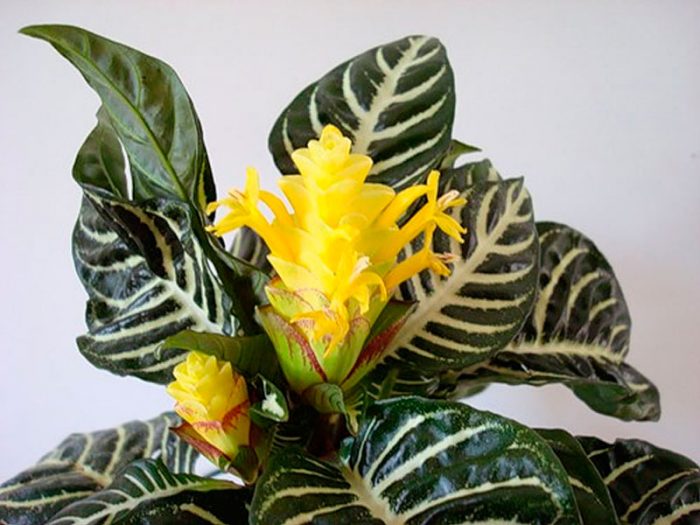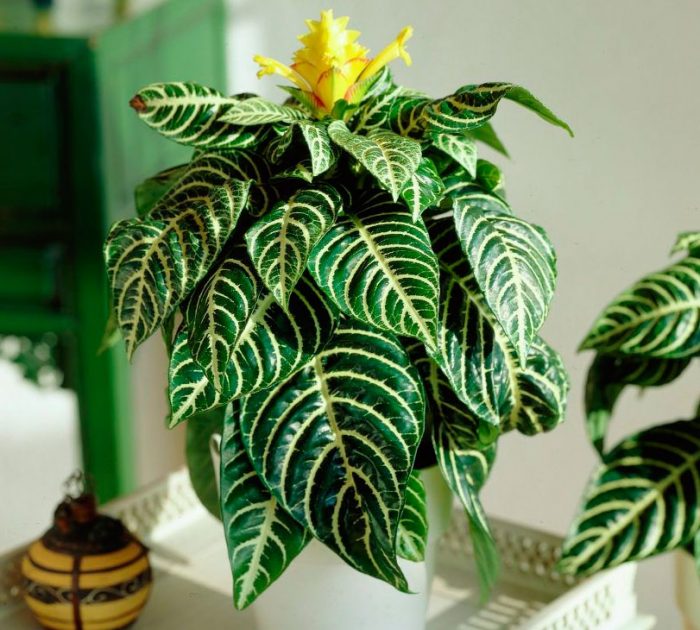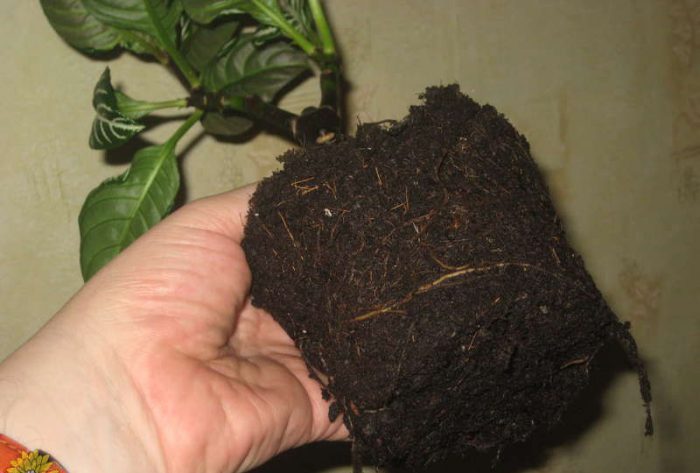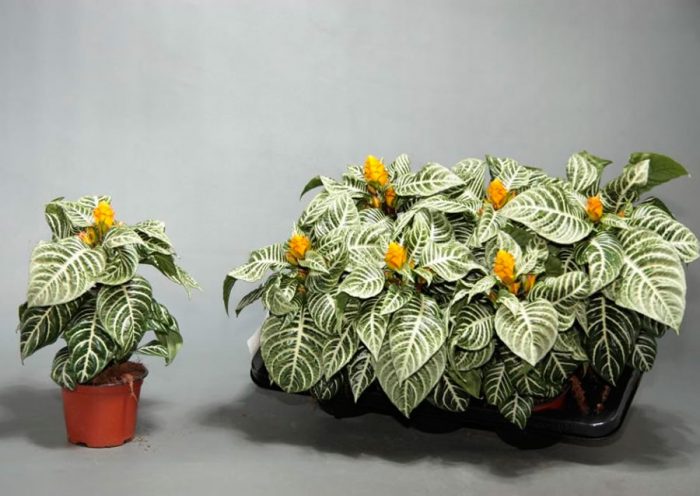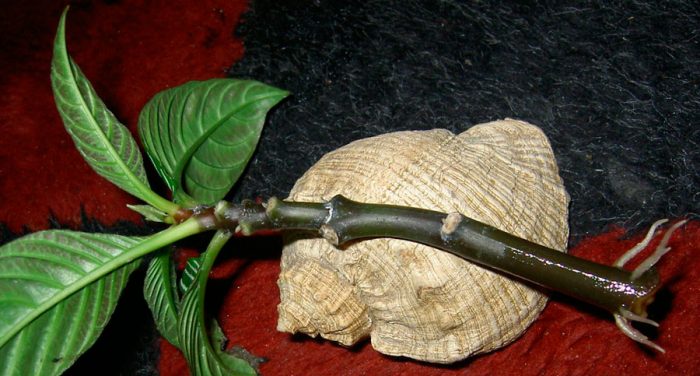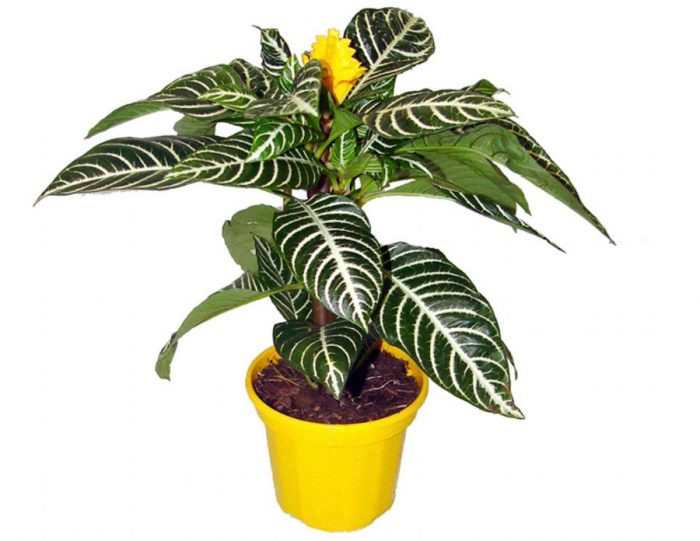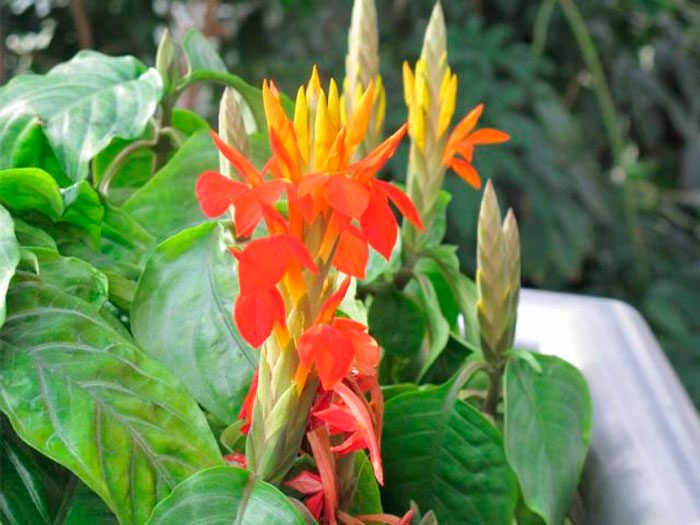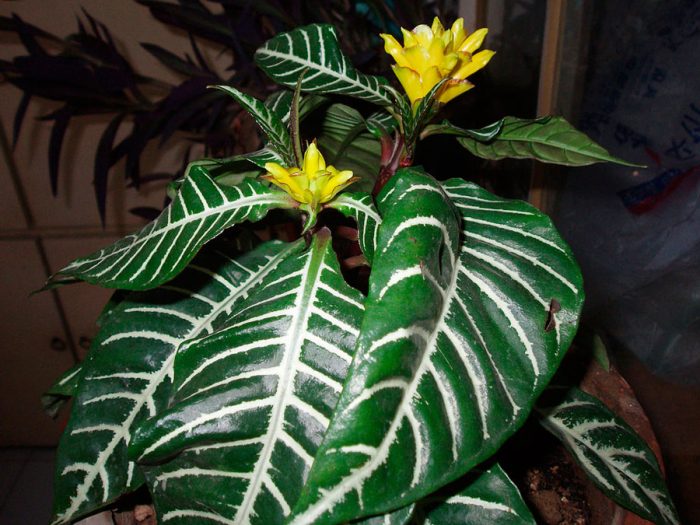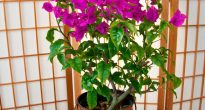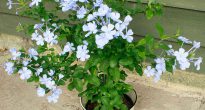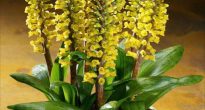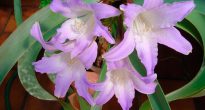Aphelandra (Aphelandra), or aphelandra, is a flowering plant belonging to the Acanthus family. In nature, this culture can be found in the tropical regions of America. The name of such a plant is formed from a pair of roots of the Greek language, the meaning of which is "a simple man", since such a flower has single-celled simple anthers. This genus unites about 200 species, some of them are cultivated at home.
Content
Features of Afelandra
In the wild, Afelandra is a herbaceous perennial plant or a low-growing shrub, the height of which reaches 200 centimeters, but in indoor culture they are not higher than 70 centimeters. Dark large glossy leaf plates are prickly or smooth, wide central and lateral veins, have a cream, white or silver color. The flowers reach 20 mm in diameter, they have hard large bracts, they sometimes have a rich color and are part of the terminal inflorescences of a spike or pineal shape, and they also have a two-lipped corolla - red, orange, lilac or yellow. The upper lip of the flowers is two-serrated, and the lower lip is three-lobed. Such an indoor flower is valuable not only because it has a very spectacular and long flowering, but also because it has large beautiful leaf plates.
Home care for Afelandra
The homeland of Afelandra is the tropics, therefore, for them to grow and develop normally, it is very important that the conditions created are close to natural. Therefore, it is so important to know how to properly care for such a plant.
This flower needs good lighting. In winter, it should be placed on a south-facing windowsill, while in summer, when the sun's rays are too hot, the plant needs a diffuse and bright color. In summer, the plant can be moved outside, but in this case it will need to be reliably protected from gusts of wind, direct rays of the sun and precipitation.
This flower is thermophilic and grows very well at normal room temperature (20 to 25 degrees). In winter, such a culture feels good in the cool, but the temperature should not drop below 16 degrees.This plant is characterized by rapid growth and over time, its lower leaf plates die off and the bush becomes less beautiful.
To make the bush thicker, it is necessary to systematically pinch the tips of its stems. In the last days of February, adult bushes are pruned before the start of the new season, while only hemp should remain from the stems, the height of which should be about 0.3 m.In order for such a plant to recover in a short time after it is pruned, it must be systematically moistened from the sprayer.
How to water
Such a culture is distinguished by its moisture-loving nature, in this regard, the soil mixture in the container should be constantly slightly moist. But you cannot very often and strongly overmoisten it. For irrigation, it is necessary to use thawed, boiled, filtered or well-settled lukewarm water.
Domestic aphelandra, like other representatives of the rainforest, needs very humid air. An electric humidifier can be used to ensure that the air in the room has the necessary humidity. However, you can simply systematically humidify the air in the room from a sprayer, or the container is placed on a pallet filled with moistened expanded clay or pebbles.
Top dressing
Such a culture needs mandatory systematic fertilization. They begin to feed the bushes in the spring, and end when they fade. To do this, you can use a mineral complex fertilizer intended for flowering house plants. Bushes should be fed 2 or 3 times every 4 weeks. In winter, this flower does not need feeding.
Transfer
When cultivating this plant in indoor conditions, it must be systematically transplanted. Young bushes in the spring should be transplanted into a new pot by transferring them. Adult bushes need to be transplanted once every 3 or 4 years.
First, drainage is poured onto the bottom of the pot, it should occupy 1/3 of the volume of the container. The composition of a suitable substrate for replanting: peat, leaf earth and sand (1: 1: 1), a small amount of charcoal and coconut fiber should be added to it.
Bloom
Indoor aphelandria sometimes bloom for a very long time: from spring to the first weeks of winter. The duration of flowering is influenced by both the type and variety of the plant, and the conditions of detention. The average flowering time is about 8 weeks. It is necessary to promptly cut off all inflorescences that have begun to fade. In order for the flowering to be lush and spectacular next year, the bush will need a mandatory period of relative rest: for this, the pot is transferred to a well-lit cool place, watering must be reduced, and the bush does not need to be fed at this time.
Reproduction of afelandra
For propagation of indoor aphelandra, seeds are used, and also a vegetative method: leaf or apical cuttings.
Seed propagation
Sowing seeds is carried out in February or March. For this, a soil mixture is used, which includes sand and leafy earth (4: 1). In order for seedlings to appear and develop faster, the crops will need heat (from 20 to 22 degrees). In order to speed up this process, you can use a mini greenhouse with bottom heating. When the seedlings grow up, they need to be cut into a soil mixture, which includes sand, leafy and soddy soil. If the plants are looked after very well, then their flowering can begin already in the first year of growth.
Propagation by cuttings
For cutting cuttings, annual matured stems with a pair of leaf plates are used, the length of which is from 10 to 15 centimeters. This should be done in March – May or December – January. In order for rooting to take place quickly in cuttings, the lower sections are treated with any drug that stimulates root growth, for example: Heteroauxin, Kornevin, succinic acid, etc.The cuttings must be planted in a cuttings with a bottom heating; it must be covered with a transparent cap. Rooting of cuttings should take place in a warm place (from 20 to 25 degrees), while they must be systematically ventilated and moistened with a soil mixture from a sprayer. Duration of rooting of stem cuttings is 6–8 weeks, and of apical cuttings - 2–4 weeks. Rooted cuttings should be planted in pots, at the bottom of which a drainage layer should be made, and the soil mixture should consist of sand, peat, humus and leafy soil (1: 2: 2: 2). Then the aphelandra is grown in the same conditions as the adult specimens.
If there is such a need, then in the autumn or winter time you need to cut off a well-developed and young leaf plate with an axillary bud. It is recommended to cut off the leaf from those shoots that have not bloomed. Cuttings should be rooted in a substrate consisting of peat and sand, while on top they need to be covered with a transparent cap. For successful rooting, cuttings need to provide a temperature of 20 to 25 degrees, they need to be systematically ventilated, and the soil mixture must be timely moistened from the sprayer.
Since, as the bushes grow, they become elongated and the lower leaf plates fly around them, in order to return the decorative effect to the old specimen, it is recommended to use the cuttings method.
Afelandra pests and diseases
Afelandra has a fairly high resistance to various diseases, but in some cases problems may arise with it.
The tips of the leaf plates may dry out near the bush., this is often due to excessively high air temperatures and low air humidity. In order for the flower to return to normal, it is necessary to regularly humidify the air from the sprayer, or the pot with the plant can be placed on a pallet that is pre-filled with wet pebbles.
Delayed flowering can occur due to poor lighting or due to a lack of nutrients in the soil mixture. To feed the flower, you should use a complex fertilizer, after which it is rearranged in a well-lit place. If necessary, the bush should be provided with additional artificial lighting.
In some cases, they can start from a bush fly around sheet plates... This can happen due to the fact that watering is not systematic, and the soil mixture in the container very often dries up. Also, the foliage can begin to fly around if the bush was watered with cold water or the direct rays of the sun fall on them. But for older copies, this process is considered normal.
If there is a constant stagnation of moisture in the soilthen the bushes may be affected by leaf mold. The affected areas must be cut out with a disinfected sharp instrument, while it is imperative to grab healthy tissue. Then the foliage is treated with a solution of the fungicidal preparation.
The greatest danger to such a culture is verticillary wilting, the bush is most often affected due to the fact that the soil is infected with a fungus. As a result of the development of such a disease, damage to the vessels of the plant is observed, while the diseased plant cannot be cured. In order to prevent, the soil mixture used for planting must be sterilized.
Harmful insects and how to deal with them
Most often, scale insects or aphids settle on the room aphelandra. These harmful insects are sucking, they suck out cell sap from young stems and foliage. If there are few insects on the bush, then in order to get rid of them, the plant should be washed under the shower using soap, while the surface of the substrate must be protected from dirty water. If scale insects have settled on the bush, then they must be removed from the foliage before the shower; for this, use a cotton swab, which is pre-moistened in alcohol or soap solution.However, if there are a lot of harmful insects on the bush, then it will need to be treated with a solution of a fungicidal preparation (Fitoverm or Aktellik), and several sprays may be required.
Types and varieties of afelandra
Aphelandra golden (Aphelandra aurantiaca), or orange
This evergreen undersized shrub has juicy and thick shoots of a light red color, while after a while they become lignified. Naked, whole-edged opposite leaf plates are painted in a greenish-silvery color, their length is about 25 centimeters, their shape is oval oblong, there is a pointed apex. The height of the spike-shaped tetrahedral inflorescences is about 15 centimeters, they consist of flowers of a rich orange color and of green bracts. Most often, a variety such as Afelandra Retzl is grown at home: a bush with large leaf plates of a whitish-silver color, the height of the inflorescences is about 15 centimeters, and the flowers are colored orange-red. This flower bears fruit well, therefore seeds are most often used for its propagation.
Aphelandra squarrosa, or aphelandra scuarrosa
This shrub is also undersized and evergreen. The fleshy bare stems are pale red. The length of the sessile leaf plates is about 0.3 m, they have a variegated color and an elliptical-oval shape. The front surface of the leaves is shiny, whitish-silvery veins are clearly visible on it, which form a pattern on a dark green background. The underside of the foliage is lighter in color. The length of the apical tetrahedral inflorescences is spike-shaped about 0.3 m, the flowers of the bushes are tubular, two-lipped. Yellow flowers look spectacular against the background of rich orange bracts. The bush blooms from the first summer weeks to November. The following varieties are popular with florists:
- Louis... The rounded stem is pale red. The length of the oblong leaf plates is about 22 centimeters; against a green background, veins of green-silver or yellow are clearly visible. The flowers are canary yellow, while the dark yellow bracts have a green vein.
- Leopold... The inflorescences are colored deep orange.
- Denmark... The color of the inflorescences is yellow. There are whitish-green veins on the surface of the dark green leaf plates.
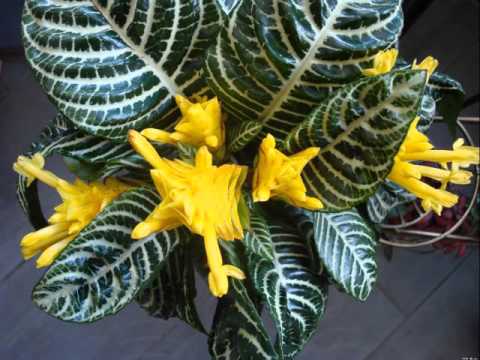

Watch this video on YouTube


